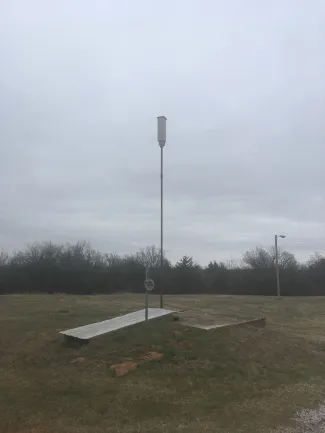Bats are extraordinary insect eaters that feast on moths, beetles, and even biting insects like mosquitoes using echolocation, a mixture of active sonar and special ear features that allow the animals to “see” with sound. While some of the insects hunted by bats are considered a mere nuisance, others can cause damage to crops or landscapes. With the idea of “free pest control” in mind, many landowners install bat boxes to welcome bats to their properties.

Bat houses, including this new "rocket box" design, are a great way to invite bats to your property. (Joe Nabonne/ODWC)
Oklahoma bats may seek out a variety of daytime retreats including caves, rock crevices, old buildings, bridges, mines and trees. Some bat species prefer large colonies while others prefer a more solitary lifestyle. At least 23 species of the flying mammals have been documented in Oklahoma; seven species are most likely to occupy bat houses in urban and rural areas. Two factors – bat house location and design – will greatly influence whether or not bats will move in to the house.
Whether you purchase a bat house or build your own, the most successful bat houses have roost chambers at least 20 inches tall and 14 inches wide. Rocket boxes, a relatively new pole-mounted design with continuous 360 degree chambers, should be at least 3 feet tall. All houses should have 3 to 6-inch landing areas extending below the entrances. Houses with at least three chambers are more likely to provide appropriate ranges of temperature and better accommodate the larger numbers typical of nursery colonies. Additionally, a vent is required on the front of the box. Ventilated houses with tall chambers allow bats to move vertically to find the best daily and seasonal temperatures.
When selecting materials for a bat house, pressure-treated wood should be avoided as it contains chemicals that may be toxic. Bats like dry, warm, draft-free houses, so careful caulking and painting are important. In Oklahoma, houses need to be painted a tan or light brown to help absorb a little heat, but not too much. Do not use oil-based products. Do not use metal mesh on landing and inside surfaces as it will tear at the bats wings and feet. Use only UV-resistant plastic mesh or put one-quarter to one-half-inch grooves on the wood surfaces for footholds. Recommended mesh size is one-eighth or one-quarter-inch mesh.
Sun exposure and heat absorption must be carefully considered when bat houses are installed. Houses should face southeast for the most sunshine and warmth. Bat houses should be within one-quarter of a mile of permanent fresh water. Single-chambered houses should be mounted on wooden or masonry buildings, which will help to buffer temperature changes. Multi-chambered bat houses should be placed on metal or wooden poles, at least 20 to 30 feet from the nearest tree branches or utility wires. Predators can use trees and wires to more easily hunt bats. The bottom of the bat house should be 12 to 20 feet above the ground. If a wooden pole is used, a predator guard is needed to keep snakes and raccoons from climbing the pole to eat the bats.
Even with the right design and location, it can take up to two summers for bats to start using the structure. If the bat house is still not occupied after two years, try a new location.
Construction plans for a rocket box and other bat house designs may be found at batcon.org.